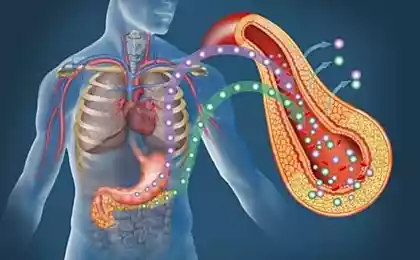234
Trembling from the cold is effective in combating obesity
Early research has already shown that moderate exercise can help turn “fat-storing” white fat into brown fat, a “good” fat that burns calories and helps keep warm. In their new study, published in Cell Metabolism, scientists say that shivering from the cold for 10-15 minutes has the same effect.
According to a research team led by Dr. Paul Lee of the Garvan Institute for Medical Research in Sydney, Australia, brown fat could be a therapeutic target in the fight against obesity and diabetes.
Humans and other mammals have two types of body fat – brown fat, also known as brown fat tissue, and white fat. The main function of brown fat is to produce heat, so newborn babies and wintering animals have higher levels of brown fat. However, researchers say that only in recent years have scientists discovered that brown fat is also present in adults, and that adults with high levels of brown fat tend to be leaner than people with low levels.
“Over the past few years, there has been a significant increase in interest in the study of brown fat because its fat-burning function makes it a potential therapeutic target against obesity and diabetes,” says Dr. Lee.
Turning white fat into brown fat may protect animals from diabetes, obesity and fatty liver disease. In addition, glucose levels in people with higher levels of brown fat tend to be significantly lower.”
According to the researchers, about 50 grams of white fat accumulates more than 300 calories, while 50 grams of brown fat can burn up to 300 calories per day. Researchers already knew that low temperatures stimulate brown fat production, causing it to burn more energy. But the underlying mechanisms were still unknown.
“When we are cold, brown fat is first activated, burning calories and generating heat to protect our bodies from hypothermia.” When this energy is not enough, the muscles begin to mechanically contract, or tremble, to produce additional heat. However, we did not know how muscle and fat communicate in this process, explains Dr. Lee.
The research team recruited volunteers who were subjected to gradually lower temperatures, from 18 degrees Celsius to 12 degrees, before the onset of tremors. Volunteers usually start shaking around 16 degrees. Since the body can perceive and respond to environmental changes through nerves and hormones, the researchers set out to study hormones activated by lower temperatures.
“We took blood samples to measure hormone levels and recorded tremors with special devices placed on the skin that detect muscle electrical activity,” says Dr. Lee.
Having done this, the researchers found that muscle shaking produces the hormone irisin, and brown fat at low ambient temperatures releases a hormone called FGF21.
Explaining hormone activity, Dr. Lee says, “These hormones activate the rate of calorie burning in white fat cells, and cold-prone fat cells begin to radiate heat, which is a feature of brown fat function.”
The researchers note that a research team from Harvard University first discovered irisin in 2012 and identified it as a muscle hormone that is activated during exercise, transforming white fat into brown fat. However, the researchers note that since physical activity generates heat on its own, they wanted to know why muscle training triggers a mechanism that produces more heat.
To find out, the same volunteers performed an exercise test. The process in which muscles produce irisin during exercise has been compared to the process in which they release the hormone through tremors. The researchers found that during a one-hour workout on a bicycle, the participants’ muscles produced the same amount of irisin as when they shivered for 10-15 minutes.
Researchers suggest that exercise can mimic tremors. Dr. Lee notes that muscles contract during both processes, and that exercise-induced irisin may have originated from shaking in cold conditions.
Overall, he notes that these findings could open the door to new treatments for obesity: "From a clinical perspective, the hormones irisin and FGF21 represent a previously unknown hormonal system that is stimulated by cold and could be used in future treatments for obesity through brown fat activation."
Source: sportmedicine.ru
According to a research team led by Dr. Paul Lee of the Garvan Institute for Medical Research in Sydney, Australia, brown fat could be a therapeutic target in the fight against obesity and diabetes.
Humans and other mammals have two types of body fat – brown fat, also known as brown fat tissue, and white fat. The main function of brown fat is to produce heat, so newborn babies and wintering animals have higher levels of brown fat. However, researchers say that only in recent years have scientists discovered that brown fat is also present in adults, and that adults with high levels of brown fat tend to be leaner than people with low levels.
“Over the past few years, there has been a significant increase in interest in the study of brown fat because its fat-burning function makes it a potential therapeutic target against obesity and diabetes,” says Dr. Lee.
Turning white fat into brown fat may protect animals from diabetes, obesity and fatty liver disease. In addition, glucose levels in people with higher levels of brown fat tend to be significantly lower.”
According to the researchers, about 50 grams of white fat accumulates more than 300 calories, while 50 grams of brown fat can burn up to 300 calories per day. Researchers already knew that low temperatures stimulate brown fat production, causing it to burn more energy. But the underlying mechanisms were still unknown.
“When we are cold, brown fat is first activated, burning calories and generating heat to protect our bodies from hypothermia.” When this energy is not enough, the muscles begin to mechanically contract, or tremble, to produce additional heat. However, we did not know how muscle and fat communicate in this process, explains Dr. Lee.
The research team recruited volunteers who were subjected to gradually lower temperatures, from 18 degrees Celsius to 12 degrees, before the onset of tremors. Volunteers usually start shaking around 16 degrees. Since the body can perceive and respond to environmental changes through nerves and hormones, the researchers set out to study hormones activated by lower temperatures.
“We took blood samples to measure hormone levels and recorded tremors with special devices placed on the skin that detect muscle electrical activity,” says Dr. Lee.
Having done this, the researchers found that muscle shaking produces the hormone irisin, and brown fat at low ambient temperatures releases a hormone called FGF21.
Explaining hormone activity, Dr. Lee says, “These hormones activate the rate of calorie burning in white fat cells, and cold-prone fat cells begin to radiate heat, which is a feature of brown fat function.”
The researchers note that a research team from Harvard University first discovered irisin in 2012 and identified it as a muscle hormone that is activated during exercise, transforming white fat into brown fat. However, the researchers note that since physical activity generates heat on its own, they wanted to know why muscle training triggers a mechanism that produces more heat.
To find out, the same volunteers performed an exercise test. The process in which muscles produce irisin during exercise has been compared to the process in which they release the hormone through tremors. The researchers found that during a one-hour workout on a bicycle, the participants’ muscles produced the same amount of irisin as when they shivered for 10-15 minutes.
Researchers suggest that exercise can mimic tremors. Dr. Lee notes that muscles contract during both processes, and that exercise-induced irisin may have originated from shaking in cold conditions.
Overall, he notes that these findings could open the door to new treatments for obesity: "From a clinical perspective, the hormones irisin and FGF21 represent a previously unknown hormonal system that is stimulated by cold and could be used in future treatments for obesity through brown fat activation."
Source: sportmedicine.ru
Algae will be used to decontaminate radioactive water at Fukushima NPP
Transport: In the United States launched the first electric bus for schoolchildren























